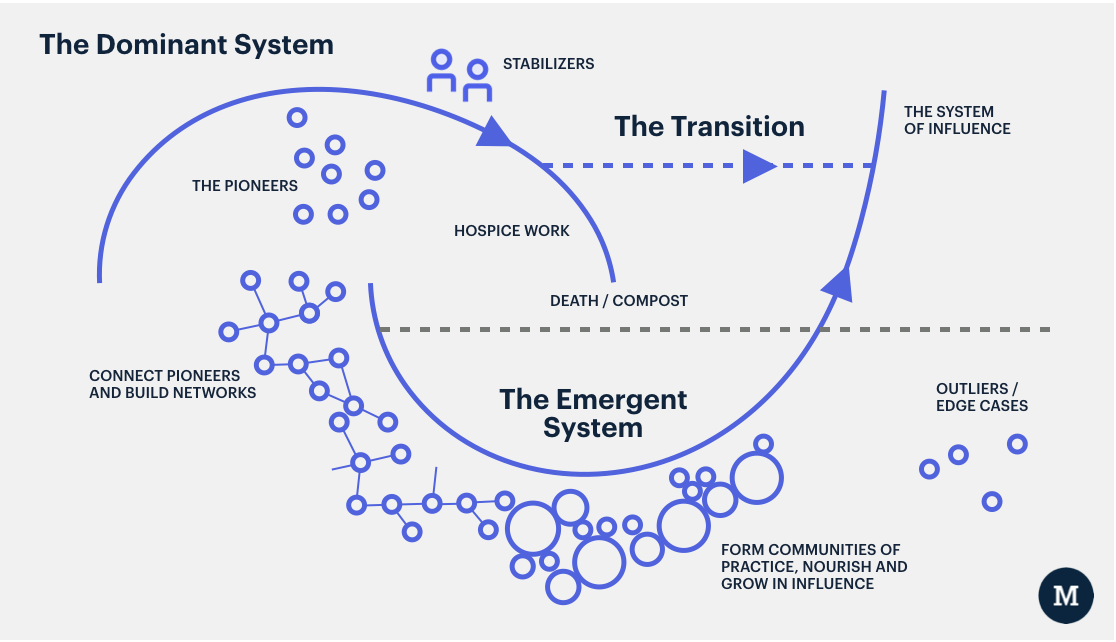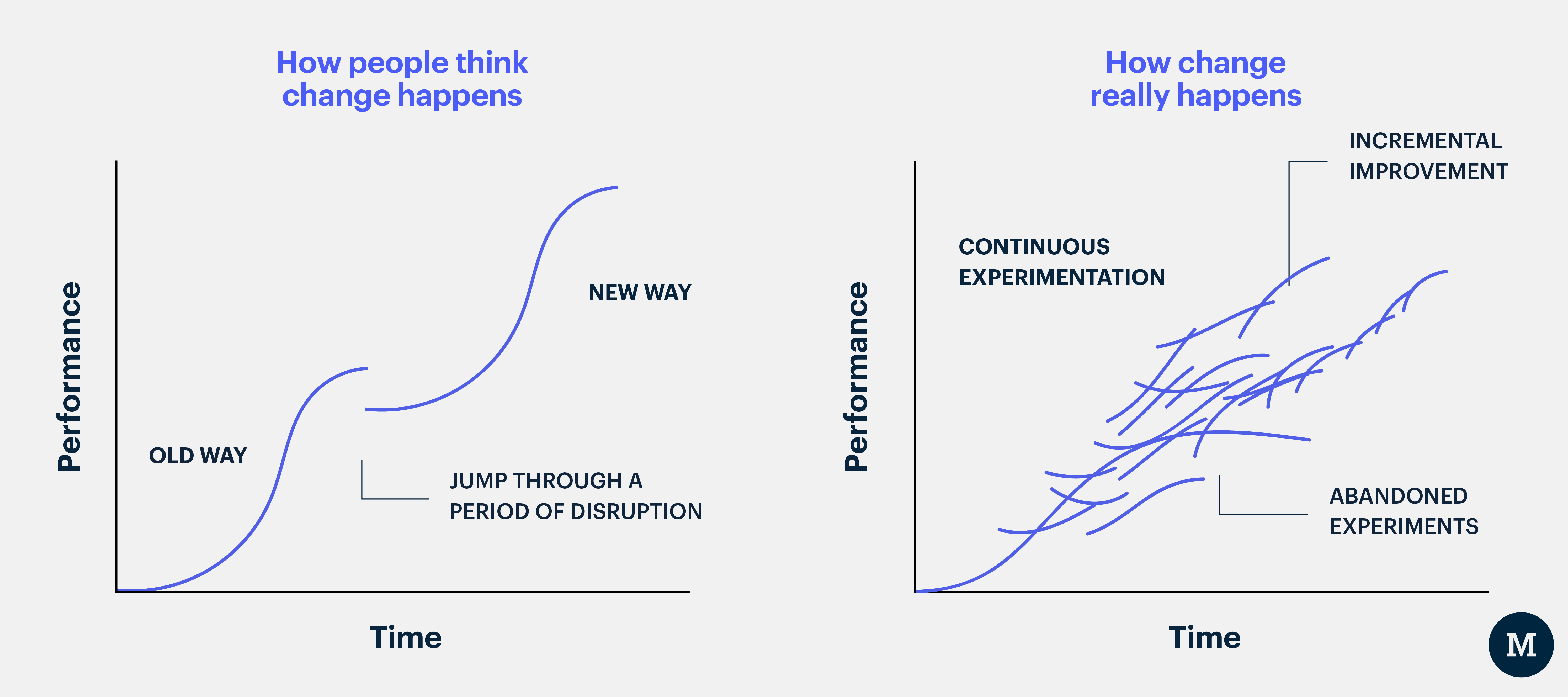Disrupt or be disrupted.. How does change really happen? And how can you impact big systemic change as one individual?
Change is changing.
Change is hard. For anyone who has attempted to break a destructive habit, adopt a positive habit, or improve their creativity (i.e. practically everybody!) we all know that it’s difficult. There are myriad approaches to doing that work in personal and professional contexts. But in this post I want to talk about BIG SYSTEMIC CHANGE. Yes, the big societal trends that are rapidly changing our environment, economies, and relationships with technology and machines. And how anyone can contribute to make a difference.
So what is the relationship between what you can do as part of your individual change effort and some of the biggest trends that are reshaping cultures and the planet?
My inspiration for this post came from the connection between two concepts that have been at the core of my thinking and practice since I began working in the innovation space approximately 17 years ago:
- The Berkana Institute “Two Loops” Theory
- Christopher Alexander’s A Pattern Language
Let’s start with the big trends.
In the earliest days of The Moment (July 2011) my co-founders, Mark and Greg and I, attended a conference called Authentic Leadership in Action (ALIA). It featured speakers and workshops about systemic change, communities of empowered people, mindfulness, and “next generation” organizations that were human-focused and more tightly harmonized with nature. Our week at that conference is a big part of The Moment’s origin story and we’re still very driven to do work that can positively impact the world.
One of the key concepts that I learned at the conference is courtesy of The Berkana Institute. The “2 Loops of Change” model suggests that at any given time in a society, there are “dominant” systems that drive the economy and culture, and there are “emergent” systems and trends that are less well known but making progress to eventually become the dominant system.
It’s a simple but powerful model that describes where pioneers and change makers are working at the edges of the system to push for change. It also describes how people in the dominant system transition (or don’t) to the new system.

The Moment’s interpretation of The Berkana Two-Loops Theory and Systems Change
Part of The Moment’s purpose involves helping to spark innovation, and encouraging progress to new, sustainable systems that will allow people and our planet to thrive. A big part of that work is ensuring that as dominant systems fade, the people who rely on those dominant systems for income, purpose, and well-being become meaningful contributors to the new system. This is where the human part of innovation is so important to us.
Innovation is not just about new technology, faster apps, and instant delivery of goods and services. It’s about the people in the system truly thriving.
It’s not just about new technology, faster apps, and instant delivery of goods and services. It’s about the people in the system truly thriving. Change is difficult and disruptive. Our passion is to spark, to guide, to amplify, and to support.
A Pattern Language: Individuals, Teams and Organizations as Levers for Change.
As someone who really appreciates and needs to see the whole and the parts of a system to push work forward, I was, and continue to be, inspired by the book, A Pattern Language by Christopher Alexander. A practicing architect, Alexander describes in great detail the essential nesting patterns from the design of a lamp in a room, to the room in which that lamp exists, to the house, to the block, to the neighbourhood, to the city, and all of the steps in between.
It’s a book that is the “bible” of an architectural grammar. But insofar as city building is one example of engaging with complex systems, the book’s contents can be easily and usefully adapted for thinking about complex systems of any kind because it starts with the smallest “units” within a system and describes how they must connect and build on each other.
From The Micro to the Macro, and the Macro to the Micro.
With these two concepts in mind, Two Loops and Pattern Language, we have complementary theories of change that can be applied together to see how individuals in their roles are essential elements to larger systemic change.
Systemic changes start with individuals who sense a need that the world could be better. These people can exist in large, legacy organizations or systems (intrapreneurs) or they can exist outside of those systems (entrepreneurs). They can be “high up” in an organization’s org chart or be a sole practitioner working out of their home.
The Moment’s purpose is to support people who are called to lead change and to support teams and organizations to do that work. Whether it’s a new product or service experience, we know that the work of change at an individual, team, organization, or system level isn’t easy. It takes lots of experiments, lots of projects, and lots of learning to find the leverage points in a system and work with them to accelerate change.
The diagram below represents a key tenet of our thinking about how change happens within organizations and teams. We can learn something about our organization and the system with every experiment. Every project and initiative is a step forward. Even the ones that “fail” can and should teach us something new.

The Moment’s Theory of Change, adapted from Dave Gray’s How Change Happens
The organizations that will successfully transition from existing in a dominant system to thriving in a new system are the ones that have a culture of openness, learning, and possibility. They will care deeply about how change affects their employees and customers. They will have empathetic leaders who empower and enable its people to drive change forward and be open to new business and operating models, rather than cling to old paradigms as they fade into history.
An Innovation Strategy, at its heart, is about understanding—and continually sensing into—macro trends occuring and creating structures all around us. An Innovation Strategy helps us to embrace the fact that change is accelerating, and that the models that have worked in the past may not work in the future, and in fact, are becoming obsolete at an ever faster pace. A robust Innovation Strategy is how organizations will be able to successfully transition from dominant systems to emerging systems.
An Innovation Strategy is all about understanding—and continually sensing into—macro trends occuring and creating structures all around us.
I hope that this post can provide some inspiration for people who see that better systems are needed but might feel helpless or disempowered. Alexander’s work illustrates that all of the “small” actors in a system are interconnected and thus very powerful. And the Berkana Two Loops model shows us that change is always happening, new models are emerging, and disruptors are on the outside, looking for allies to amplify change.
From a practical standpoint, we know that change happens by doing the work, through continuous experimentation, and iterative learning. And that’s exactly how we coach our clients looking to make change in both large organizations and start-up environments, for change big and small. Innovation isn’t a stagnant state, but something that happens by doing.
We are always looking to connect with change champions and innovators, so reach out and let us know you’re out there!









